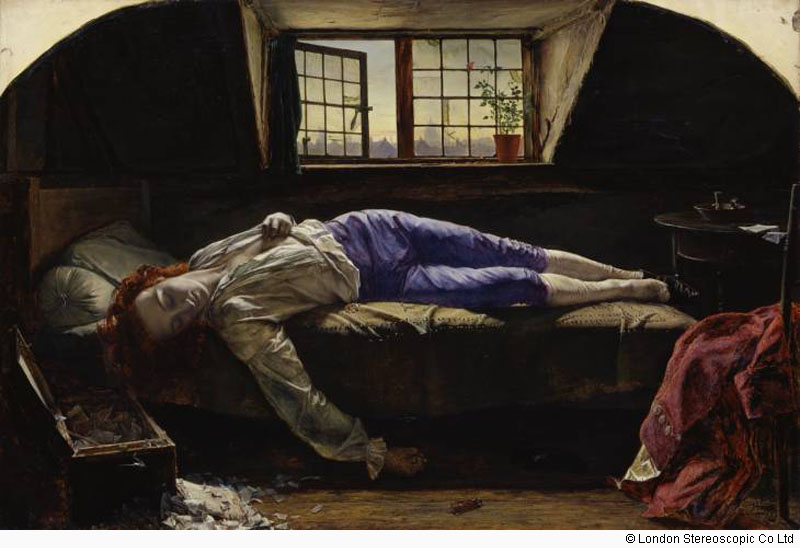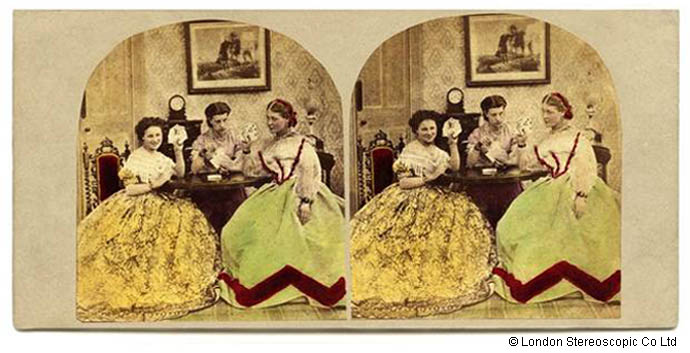A selection of Brian’s stereoscopic pictures are going on loan to Tate Britain gallery in an exhibition from October through to April 2015.
TATE BRITAIN`
Address: Millbank
London SW1P 4RG
Phone +44 (0)20 7887 8888
Information 09.00–18.00, daily; Membership and ticketing services 9.45–18.00, daily
Email visiting.britain@tate.org.uk
BP Spotlight: ‘Poor man’s picture gallery’: Victorian Art and Stereoscopic Photography
Tate Britain: Display
13 October to 12 April
Part of the series BP Spotlights

Henry Wallis
Chatterton 1856
Oil on canvas
Support: 622 x 933 mm frame: 905 x 1205 x 132 mm
Bequeathed by Charles Gent Clement 1899
‘Poor man’s picture gallery’: Victorian Art and Stereoscopic Photography is the first display in a major British art gallery devoted to early three-dimensional photography.
These ingenious but inexpensive stereograph pictures were a nineteenth century craze, circulating world-wide in tens of thousands and more.
Pioneers of the art form were quick to challenge fine art itself. Celebrated canvases of the age, such as Henry Wallis’s Chatterton and Francis Frith’s Derby Day, were recreated in real depth.
This display brings twelve of Tate’s Victorian and Pre-Raphaelite works face to face with a rare collection of their three-dimensional doubles assembled by Brian May.
Viewers can finally appreciate the interpretations that the photographers explored and the ways they brought the paintings to life.
—
PRESS:
THE INDEPENDENT
BRIAN MAY’S COLLECTION OF 3D STEREOSOPIC PHOTOGRAPHY TO GO ON DISPLAY AT TAKE MODERN
31 August 2014 by Nick Clark

The former Queen guitarist has lent his collection of stereoscopic pictures to Tate Modern
The Victorian craze for 3D stereoscopic photography is to be the subject of a major gallery exhibition for the first time – thanks to former Queen guitarist Brian May. The veteran rock star has lent his extensive personal collection of stereoscopic pictures – which use two photographs to conjure a 3D image – to Tate Britain for a new exhibition opening next month.
May, 67, who has been collecting the images for more than 40 years, told The Independent he was delighted that the Tate was highlighting a photographic technique that had been “neglected by art historians for 150 years”.
The exhibition, A Poor Man’s Picture Gallery: Victorian Art and Stereoscopic Photography, is focusing on photographs that recreate artworks in Tate’s collection, such as Henry Wallis’ Chatterton, and the card players in Hearts are Trumps by 19th Century painter Sir John Everett Millais.
Carol Jacobi, curator at Tate, said: “These photographs were a real craze in the 1850s and 1860s, all over the world, not just in Britain. This is the first major British gallery to focus on this form of photography.”
The two photographs in stereoscopic pictures – which are taken from a slightly different angle – are displayed side by side. When seen through a special viewer they give the illusion of three dimensions.

Chatterton-Robinson, Michael Burr, The Death of Chatterton c. 1861.
Photograph, hand coloured albumen prints on stereo card
In the 1850s, they became hugely popular with the public and could be bought for a few shillings or even rented. Photographers including Michael Burr and Thomas Richard Williams were particular associated with the form.
“Stereoscopic photographs were so ubiquitous at the time and were seen as pretty disposable,” Dr Jacobi said. “They are now quite difficult to track down. That’s why we collaborated with Brian May, he has built a collection over 40 years.”
There are 26 sets of stereoscopic photographs in the exhibition. Some will be hung on the wall for the exhibition and there will be 12 examples to be seen through a viewer.
May said his love of stereoscopic photography started from collecting 3D cards that came free in packets of Weetabix breakfast cereal. “I sent away for the viewer which made the cards spring to life in stereoscopic splendour. When I saw that this magic could be achieved, I couldn’t see the point of limiting photography to two dimensions,” he said. He continued to collect throughout his music career and touring with Queen, contacting photo dealers around the world. He has built up a collection of tens of thousands of pieces stereoscopic material, though those from the mid-19th century are the rarest.
Dr Jacobi said: “In the 19th century, photograph versions of paintings had enormous audiences. Though most have been lost, these ones have never been displayed with the actual paintings.”